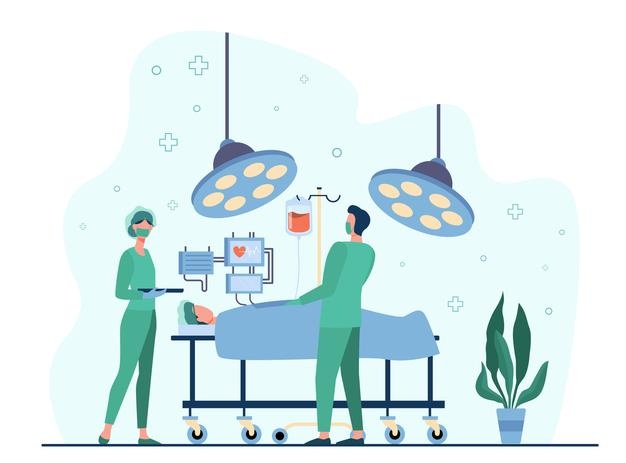What is Varicocele?
Varicocele
Varicocele is a condition that affects men. The medical condition known as varicocele causes the veins in the scrotum to enlarge. The purpose of these veins is to transport deoxygenated blood from the scrotum. However, in some cases, the blood might get pooled in these veins, instead of it being efficiently circulated in and out of the scrotum. This condition is similar to getting a varicose vein in the legs. The veins inside the scrotum get twisted and enlarged. Varicoceles are formed in puberty and they will eventually develop. Varicoceles might grow larger and become more noticeable over time. Varicoceles are found more on the left side of the scrotum rather than on the right.
Microscopic Varicocelectomy and Laparoscopic Varicocelectomy.
In a microscopic varicocelectomy, an incision is made above the scrotum. This incision is about a centimeter long. The small veins present in the area, the spare vas deference, arteries, lymphatic drainage, etc. are ligated or tied up by the medical professional. This is done with the aid of a microscope. This medical procedure only takes about two or three hours and the patient can be discharged and sent home on the same day. In a laparoscopic varicocelectomy vein ligation is performed. The medical professional will insert thin tubes into the abdomen of the patient and ligate the veins. This procedure takes only thirty to forty minutes and the patient can be sent home the same day as well.
- PROCEDURE NAME : Microscopic Varicocelectomy and Laparoscopic Varicocelectomy.
- SURGERY TYPE: Minimally Invasive LASER
- HOSPITALIZATION: HOSPITALIZATION
- SURGERY DURATION: 30 minutes
- ANAESTHESIA: Spinal Block / General Anaesthesia
- FULL RECOVERY: 3 - 4 days
TREATMENTS
Diagnosis
Varicoceles can be diagnosed by a doctor. It can be identified during a physical examination. Varicocele has been said to look and feel like a bag of worms. Urologists often administer the Valsalva maneuver, in order to check for a varicocele. The physical exam is performed on the patient while the patient is standing up, as the varicoceles are not visible while the patient is lying down. In some cases, the doctor takes a testicular ultrasound to determine the condition of the varicocele. However, an ultrasound is only required if there has been any problem while performing the physical examination on the patient. Once they are identified, they will be categorized into three grades, considering the size of the lump in the testicles. Grade one is considered to be the smallest and grade 3 is the largest. The treatment of the varicocele is not necessarily done for the size of the lump, it is treated according to the level of discomfort or if it’s causing infertility.
Surgery

In the majority of the cases, varicoceles do not require any treatment. However, if the varicocele come with symptoms such as infertility, pain, etc. the person might need medical attention. There arent a wide array of medicines to treat or prevent varicoceles. However, in case varicoceles are causing pain, pain relievers and anti-inflammatory medication are prescribed. The main treatment for varicoceles is surgery. There are different kinds of surgeries that can be done to treat varicoceles. The blood flow in the pampiniform lexes is blocked in a varicocele surgery. Mainly there are two types of surgeries; microscopic varicocelectomy and laparoscopic varicocelectomy. In a microscopic varicocelectomy, an incision is made above the scrotum. This incision is about a centimeter long. The small veins present in the area, the spare vas deference, arteries, lymphatic drainage, etc. are ligated or tied up by the medical professional. This is done with the aid of a microscope. This medical procedure only takes about two or three hours and the patient can be discharged and sent home on the same day. In a laparoscopic varicocelectomy vein ligation is performed. The medical professional will insert thin tubes into the abdomen of the patient and ligate the veins. This procedure takes only thirty to forty minutes and the patient can be sent home the same day as well.
Causes
- Chronic constipation
- Nausia
- obesity
Symptoms
- Discomfort while sitting
- Painful bowel movements
- Swelling & Itching
- Excessive Bleeding
Frequently Asked Questions
Does varicocele require treatment?
Not all varicoceles require treatment. You only need medical attention if the varicocele is causing severe pain or discomfort. Varicocele has also been seen to cause infertility, in such cases treatment is a requirement.
What is the medication for varicocele?
In most cases, for varicoceles, pain relievers and anti-inflammatory medication is given.
What are the treatment options for varicoceles?
The major treatment option for varicocele is surgery. The pampiniform plexus veins are surgically blocked.
Can I father a child if I have varicocele?
In most cases of varicocele, there shouldn’t be a problem. However, in some cases, varicocele is seen to cause infertility. Seek medical help in such cases.
What kind of surgery is done to treat varicoceles?
Mainly there are two types of surgery done to treat varicoceles. Microscopic varicocelectomy and laparoscopic varicocelectomy. In a microscopic varicocelectomy, an incision is made above the scrotum. The small veins present in the area, the spare vas deference, arteries, lymphatic drainage, etc. are ligated or tied up by the medical professional. In a laparoscopic varicocelectomy vein ligation is performed. The doctor will insert thin tubes into the abdomen of the patient and ligate the veins.
[metaslider id="2120"]

